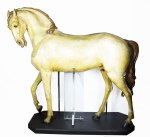
Next week at the Society for the History of Technology annual meeting in Philadelphia, I will be presenting “Manufacturing the Horse: Understandings of Inheritance in the Long 18th Century” as part of the Maintaining Natures II panel (and I won’t be the only equine paper! Felicity McWilliams of Kings College London will be presenting “Maintaining Tractors and Caring for Horses: Looking after Draught Power Technologies in Twentieth Century British Farming.”) What began as a simple question– what were the genetics behind the unusual colors of the Hanoverian Cream and Hanoverian White– uncovered some surprising features of early modern horse breeding.
Before returning to academics, I was a horse trainer. When I started out, I was taught to breed ‘like to like.’ You selected for your mare a stallion of same type, the same general size and shape, regardless of whether he was of the same breed. Among thoroughbred breeders the saying goes “breed the best to the best, and hope for the best.”[1] This very unscientific method of breeding selection has been assumed to be the norm prior to advent of modern genetics. Because early modern treatises often included detailed accounts of correct star positions for auspicious breedings, humoral theory, telegony, and even suggestions on how to influence the color of a foal through what the mare saw while being bred or while pregnant, this assumption has seemed well founded. However, there is often a disconnect between canonical knowledge and applied knowledge, and in early modern breeding that disconnect is a gulf. It is clear that a great deal more thought went in to the choosing of well matched mates than in to following the rules of the stars.
If we look only a short time back, it is easy to suggest breeders simply bred like to like. The development of modern breeds (of dogs, cattle, sheep, and other livestock as well as among horses) at the end of the nineteenth and beginning of the twentieth centuries relied heavily on inbreeding to fix desired traits. The studbooks that were rare in the eighteenth century were not only increasingly common but also increasing closed, moving from recording progeny and achievements to codifying what animals were allowed to belong, and allowed to be bred. However, this was not a continuation of prior practices, but rather a break from them. The creation, and subsequent closing, of studbooks represented new concepts of breeding, relying on the previously taboo “in and in” breeding, being then defined as loosely as mating two animals produced by the same farm. The word “breed” itself changed, from meaning a group bred by a particular person to meaning an animal belonging to a pedigreed, reproducible family.
Stop by Maintaining Natures II, or follow #SHOT2017 and #HorseHistory, to hear more.
[1] I’ve dated a version of this phrase to 1893 Agricultural Journal of the Cape of Good Hope, Volume 6 By Cape of Good Hope (Colony). Dept. of Agriculture
[…] of Pennsylvania) Katrin Boniface (University of California Riverside) [Robinson Prize Candidate]: Manufacturing the Horse: Understandings of Inheritance in the Long 18th Century Felicity McWilliams (King’s College London): Maintaining Tractors and Caring for Horses: Looking […]
LikeLike
[…] He’s not wrong. […]
LikeLike